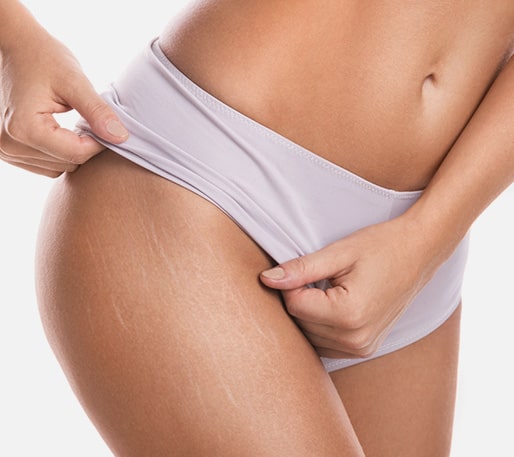
What are scars & stretch marks?
Scars and stretch marks (striae) are the result of over-stressed skin. Scars form part of the skin’s healing process whenever multiple layers of skin are injured. The injury may be the result of an accident, surgery, a burn or even severe acne.
The Laser & Skin Surgery Center of Northern California’s physicians are considered top experts in their field when it comes to scar and stretch mark treatments in the Sacramento region.
What causes stretch marks?
While the exact cause of stretch marks is unknown, it is thought that they are the result of your skin’s collagen and elastin breaking down. They occur most frequently in areas of mechanical stress such as the breasts, abdomen, thighs, groin or buttocks. Pregnancy, body building, weight gain and hormone changes are the leading causes of stretch marks. At first, stretch marks are red or purple. They often turn white as part of the healing process.
In the past, cryosurgery (freezing), excision, steroid injections and the use of topical creams and ointments were the standard of care for the treatment of scars and stretch marks. The results of these treatments range from fair to minimal, with recurrences commonly seen after many of these treatment options.
Today, several new laser techniques are available to treat a wide variety of scars and stretch marks. The laser’s energy stimulates the skin under the scar and stimulates collagen breakdown and production of new collagen. This remodeling of the skin under the scar helps it more closely resemble the surrounding normal skin.
Does laser treatment hurt?
Most patients do not require anesthetic. Some patients have indicated that they feel a slight tingling when the laser pulses, or that the laser pulse feels like a snap of a rubber band against the skin.
How do laser treatments help scars?
How soon will I see results?
Results vary from patient to patient and may not be immediate. Results from laser scar and stretch mark treatment are generally progressive and may require multiple treatments. For stretch marks, we perform a test site first to confirm that you will respond. If you respond to the first treatment, your second treatment will usually be as good as the first, and the third treatment will be almost as good. Additional studies show that the appearance of stretch marks continues to improve over a period of time ranging from three to six months after the laser treatment was performed. Even patients who showed little, if any, initial improvement showed as much as a 50% improvement at their six month checkup. About 70% of patients receiving laser treatments for their stretch marks notice a marked improvement. Newer and shallower stretch marks and scars respond better than older and deeper scars and stretch marks. The use of tretinoin cream or glycolic acid cream prior to and after your laser treatments may enhance your results.
What is recovery like?
The skin in the immediate treatment area may be red for up to two weeks, but it does not usually cause any discoloration or other markings on the skin. The low power setting of the laser only stimulates the skin and does not harm any healthy tissue.
Am I a good candidate?
The patients that respond the best to laser treatment for scars and stretch marks are those with fair complexion and light pigmentation, as well as shallow scars or stretch marks.
Note: Patients with a history of Vitiligo, pigmentation disorders, dark tans or dark pigmentation may require an initial skin test for evaluation prior to treatment.


